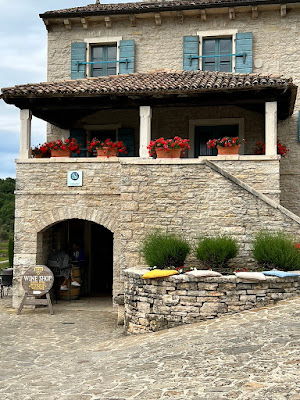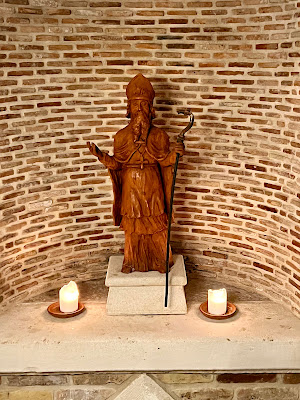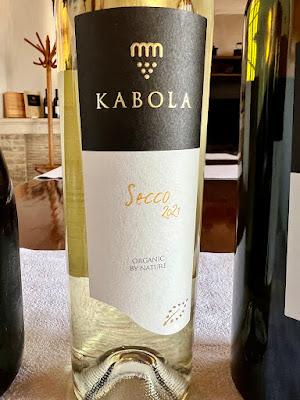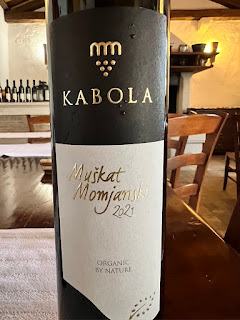In 2000, the winery was rebranded as Kabola, which is a family nickname in Italian. In the small village where the Markežić grew up, there were many with that surname, so they all acquired nicknames to help differentiate each other. The family speaks both Croatian and Italian, which is very common in Istria which has been owned by Italy in the past.
This is Anne Markežić, who led us on our tour, and she was personable, knowledgeable and passionate. They established this winery location in 2000, and it took five years to construct the wine cellar, so the winery officially opened in 2005, although their first vintage was in 2003. Currently, they are constructing a second wine cellar, which should be completed next year.
The house on their property, a traditional Istrian home, was built back in 1912, although they had to renovate it a bit. The winery is located about 5 km from the Adriatic Sea. Their annual production is about 110K bottles, with Malvazija Istarska constituting about 50% of their production. As an aside, a recent movie, Hitman's Wife's Bodyguard, was filmed at the winery.
The 2003 Teran was the first wine released under the Kabola label.
The winery owns 10 hectares of vineyards around the winery, and 10 hectares elsewhere, generally older vines. Since 2009, their vineyards have been certified organic, and they use only estate grapes for their wines. The vineyards generally have white soils, mainly clay with lots of marl, which provide some minerality to their wines. Sustainability is very important to them, which certainly is an excellent objective.
A sign commemorating the new winery, established in 2000, by Anne's father, Marino.
As you enter their property, one of the first items you'll see is a displayed amphora (actually a Georgian qvevri), indicative of a significant aspect of the winery, their passion for "amphorae" wines. Although the winery often refers to these as amphorae, and I will continue doing so in much of this article, technically they are qvevri, and have been obtained from Georgia.
When you descend into the winery's cellar, you'll find a shrine to St. Martin, the Croatian patron saint of wine. His Feast Day is celebrated on November 11, and a number of Croatian wines have statues to St. Martin.
Their barrels are all made from Slavonian oak, although the barrels are constructed in Italy.
Of course, for our wine tasting, the winery provided us a large platter of local meats and cheeses. They also own about 200 olive oil trees, of Italian varieties, which are also organic.
We began our wine tasting with some bubbly, the NV Kabola Re Brut, which is primarily from the 2016 vintage and is a blend of 70% Malvazija Istarska, 20% Chardonnay, and 10% Pinot Noir. At 13% ABV, the wine spent 5 years on the lees, and it was intriguing to see the six circular sections of bubbles when I looked directly down into the glass. The sparkling wine had an alluring aroma, and on the palate it was crisp and dry, with prominent apple and stone fruit flavors, and a hint of spice. Complex, with a nice richness to the mouthfeel and a lengthy, pleasing finish. An excellent start to the tasting!
The 2021 Kabola Secco, with 13% ABV, was produced from Muscat of Momjan. This grape is a type of Muscat which has been in the Istrian region for over 800 years. This was a dry wine, with only 3 grams of residual sugar, and saw no oak. It was very aromatic, with an intriguing taste of spice, floral notes and subtle tropical fruit flavors. There was plenty of complexity to it, and each sip was pleasing and interesting.
The 2021 Kabola Malvazija Istarska, with a 14% ABV, also saw no oak and was fresh and easy drinking, with a bright, fruity nose. On the palate, there were flavors of apple, lemon, and grapefruit, with some minerality, especially on the finish. Delicious.
The 2021 Kabola Teran Rosa, with a 13% ABV, is a Rosé wine. The wine had a slightly rustic aroma, and on the palate there were flavors of strawberry and raspberry, with mild herbal notes, some minerality, and a long finish. It was dry, fresh, and tasty.
The 2019 Kabola Unica, with a 14% ABV, is produced from Malvazija Istarska. It spent about a week with skin contact and was aged in 4K liter Slavonian oak barrels for about a year on the lees. This was a superb, complex and complex wine, so different from the prior Malvazija. It was much more savory in nature, with only subtle fruit notes. There was a nice salinity to it, with a touch of almonds, and a fine richness to the mouthfeel. Its finish lingered and lingered, bringing much pleasure. Highly recommended.
The 2018 Kabola Amfora Malvazija Istarska, with a 13% ABV, spent about 6 months in amphorae, although only the berries were used, none of the green parts. They used an old, gentle press for the grapes, which are from one of the best vineyard positions, so they wouldn't get the sourness of the seeds. Afterwards, the wine was put in 4K liter barrels for a year, and then another year in the barrel. This wine is still very young, and needs about two years to develop. The wine was clean and dry, with interesting savory and herbal notes, and firm tannins. I'd love to see how this evolves with a couple years in the bottle. We were also told that this wine could remain in the bottle for 50 years.
The 2016 Kabola Amfora Teran, with a 13% ABV, also spent 6 months in amphorae, and then one year in oak and one year in the bottle. Teran, the major red grape of Istria, is a powerful grape, with strong tannins, but the amphorae made it rounder and softer. It became an elegant wine, with delicious red and black fruit flavors, from raspberry to plum, subtle spice notes and a lengthy, satisfying finish. An excellent wine, and highly recommended!
Our final wine of the tasting was the 2021 Kabola Muskat Momjanski, with a 12.5% ABV. It is semi-sweet, although it's definitely not overly sweet. It possessed an intense nose, of Muscat spices and fruit, and on the palate, there were delightful notes of honey and tropical fruit. A delicious and fine wine for after-dinner or paired with dessert.
Near the end of our tour, Marino Markežić stopped by to greet us. Kabola is producing impressive wines, and their dedication and passion for qvevri wines is more than evident. This was an excellent introduction to the wines of Istria, and I'd highly recommend any visitors to this region to stop by Kabola. Malvazija Istraska and Teran are two important Istrian grapes, and Kabola showed us some of the potential of these intriguing grapes. Kudos to Marino and Anne!
The winery owns 10 hectares of vineyards around the winery, and 10 hectares elsewhere, generally older vines. Since 2009, their vineyards have been certified organic, and they use only estate grapes for their wines. The vineyards generally have white soils, mainly clay with lots of marl, which provide some minerality to their wines. Sustainability is very important to them, which certainly is an excellent objective.
A sign commemorating the new winery, established in 2000, by Anne's father, Marino.
As you enter their property, one of the first items you'll see is a displayed amphora (actually a Georgian qvevri), indicative of a significant aspect of the winery, their passion for "amphorae" wines. Although the winery often refers to these as amphorae, and I will continue doing so in much of this article, technically they are qvevri, and have been obtained from Georgia.
With the construction for their new wine cellar ongoing, you can spy a number of amphorae laying on their side. These all used to be buried underground, but have been dug up while the construction is ongoing. We were told that in 2000, Kabola was the first winery in Croatia to use amphorae. Marino had visited Georgia, and wanted to produce a different type of wine, so he decided to acquire some amphorae. Their first amphora wine, a Malvazija Istarska, was produced in 2003, and they now own eight, 2000-liter terra-cotta qvevri from Georgia. However, next year, they plan to own 24 amphorae, creating their own Temple of Amphorae.
When you descend into the winery's cellar, you'll find a shrine to St. Martin, the Croatian patron saint of wine. His Feast Day is celebrated on November 11, and a number of Croatian wines have statues to St. Martin.
Their barrels are all made from Slavonian oak, although the barrels are constructed in Italy.
Of course, for our wine tasting, the winery provided us a large platter of local meats and cheeses. They also own about 200 olive oil trees, of Italian varieties, which are also organic.
We began our wine tasting with some bubbly, the NV Kabola Re Brut, which is primarily from the 2016 vintage and is a blend of 70% Malvazija Istarska, 20% Chardonnay, and 10% Pinot Noir. At 13% ABV, the wine spent 5 years on the lees, and it was intriguing to see the six circular sections of bubbles when I looked directly down into the glass. The sparkling wine had an alluring aroma, and on the palate it was crisp and dry, with prominent apple and stone fruit flavors, and a hint of spice. Complex, with a nice richness to the mouthfeel and a lengthy, pleasing finish. An excellent start to the tasting!
They also produce a Blanc de Blancs, from 100% Chardonnay, and noted that they don't use Malvazija as it needs support in the bottle, and doesn't stand well on its own in sparkling wine. We were also told that they grow only a small amount of Pinot Noir, which is only used in their sparkling wine.
The 2021 Kabola Secco, with 13% ABV, was produced from Muscat of Momjan. This grape is a type of Muscat which has been in the Istrian region for over 800 years. This was a dry wine, with only 3 grams of residual sugar, and saw no oak. It was very aromatic, with an intriguing taste of spice, floral notes and subtle tropical fruit flavors. There was plenty of complexity to it, and each sip was pleasing and interesting.
The 2021 Kabola Malvazija Istarska, with a 14% ABV, also saw no oak and was fresh and easy drinking, with a bright, fruity nose. On the palate, there were flavors of apple, lemon, and grapefruit, with some minerality, especially on the finish. Delicious.
The 2021 Kabola Teran Rosa, with a 13% ABV, is a Rosé wine. The wine had a slightly rustic aroma, and on the palate there were flavors of strawberry and raspberry, with mild herbal notes, some minerality, and a long finish. It was dry, fresh, and tasty.
The 2019 Kabola Unica, with a 14% ABV, is produced from Malvazija Istarska. It spent about a week with skin contact and was aged in 4K liter Slavonian oak barrels for about a year on the lees. This was a superb, complex and complex wine, so different from the prior Malvazija. It was much more savory in nature, with only subtle fruit notes. There was a nice salinity to it, with a touch of almonds, and a fine richness to the mouthfeel. Its finish lingered and lingered, bringing much pleasure. Highly recommended.
The 2018 Kabola Amfora Malvazija Istarska, with a 13% ABV, spent about 6 months in amphorae, although only the berries were used, none of the green parts. They used an old, gentle press for the grapes, which are from one of the best vineyard positions, so they wouldn't get the sourness of the seeds. Afterwards, the wine was put in 4K liter barrels for a year, and then another year in the barrel. This wine is still very young, and needs about two years to develop. The wine was clean and dry, with interesting savory and herbal notes, and firm tannins. I'd love to see how this evolves with a couple years in the bottle. We were also told that this wine could remain in the bottle for 50 years.
The 2016 Kabola Amfora Teran, with a 13% ABV, also spent 6 months in amphorae, and then one year in oak and one year in the bottle. Teran, the major red grape of Istria, is a powerful grape, with strong tannins, but the amphorae made it rounder and softer. It became an elegant wine, with delicious red and black fruit flavors, from raspberry to plum, subtle spice notes and a lengthy, satisfying finish. An excellent wine, and highly recommended!
Our final wine of the tasting was the 2021 Kabola Muskat Momjanski, with a 12.5% ABV. It is semi-sweet, although it's definitely not overly sweet. It possessed an intense nose, of Muscat spices and fruit, and on the palate, there were delightful notes of honey and tropical fruit. A delicious and fine wine for after-dinner or paired with dessert.
























No comments:
Post a Comment